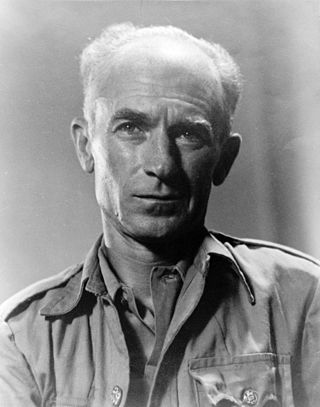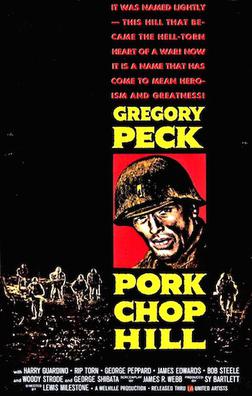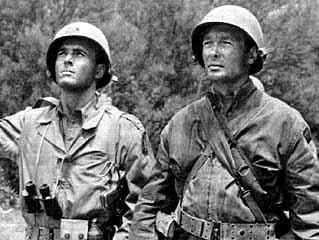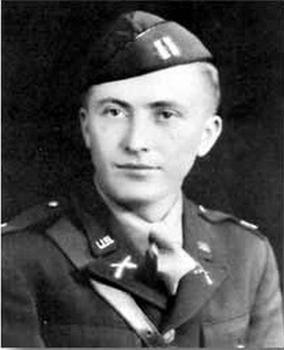
Wings is a 1927 American silent and synchronized sound film known for winning the first Academy Award for Best Picture. Due to the general public's apathy towards silent films, the film was quickly re-released in 1928 with synchronized sound. While the sound version of the film has no audible dialogue, it was released with a synchronized musical score with sound effects.

Robert Charles Durman Mitchum was an American actor. He is known for his antihero roles and film noir appearances. He received nominations for an Academy Award and a BAFTA Award. He received a star on the Hollywood Walk of Fame in 1984 and the Golden Globe Cecil B. DeMille Award in 1992. Mitchum is rated number 23 on the American Film Institute's list of the greatest male stars of classic American cinema.

William Henry Mauldin was an American editorial cartoonist who won two Pulitzer Prizes for his work. He was most famous for his World War II cartoons depicting American soldiers, as represented by the archetypal characters Willie and Joe, two weary and bedraggled infantry troopers who stoically endure the difficulties and dangers of duty in the field. His cartoons were popular with soldiers throughout Europe, and with civilians in the United States as well. However, his second Pulitzer Prize was for a cartoon published in 1958, and possibly his best-known cartoon was after the Kennedy assassination.

Ernest Taylor Pyle was a Pulitzer Prize–winning American journalist and war correspondent who is best known for his stories about ordinary American soldiers during World War II. Pyle is also notable for the columns he wrote as a roving human-interest reporter from 1935 through 1941 for the Scripps-Howard newspaper syndicate that earned him wide acclaim for his simple accounts of ordinary people across North America. When the United States entered World War II, he lent the same distinctive, folksy style of his human-interest stories to his wartime reports from the European theater (1942–44) and Pacific theater (1945). Pyle won the Pulitzer Prize in 1944 for his newspaper accounts of "dogface" infantry soldiers from a first-person perspective. He was killed by enemy fire on Iejima during the Battle of Okinawa.

Oliver Burgess Meredith was an American actor and filmmaker whose career encompassed radio, theater, film, and television.

Audie Leon Murphy was an American soldier, actor, and songwriter. He was widely celebrated as the most decorated American combat soldier of World War II, and has been described as the most highly decorated soldier in U.S. history. He received every military combat award for valor available from the United States Army, as well as French and Belgian awards for heroism. Murphy received the Medal of Honor for valor that he demonstrated at the age of 19 for single-handedly holding off a company of German soldiers for an hour at the Colmar Pocket in France in January 1945, before leading a successful counterattack while wounded and out of ammunition.

A Walk in the Sun is a 1945 American war film based on the novel by Harry Brown, who was a writer for Yank, the Army Weekly based in England. The book was serialized in Liberty Magazine in October 1944.

Pork Chop Hill is a 1959 American Korean War film starring Gregory Peck, Woody Strode, Rip Torn, and George Peppard. The film, which was the final war film directed by Lewis Milestone, is based upon the 1956 book by U.S. military historian Brigadier General S. L. A. Marshall. It depicts the first fierce Battle of Pork Chop Hill between the U.S. Army's 7th Infantry Division and Chinese and North Korean forces in April 1953.

Sgt. Franklin John Rock is a fictional character appearing in American comic books published by DC Comics. Sgt. Rock first appeared in Our Army at War #83, and was created by Robert Kanigher and Joe Kubert. The character is a World War II soldier who served as an infantry non-commissioned officer.

William Augustus Wellman was an American film director, producer, screenwriter, actor and military pilot. He was known for his work in crime, adventure, and action genre films, often focusing on aviation themes, a particular passion. He also directed several well-regarded satirical comedies. His 1927 film, Wings, was the first film to win an Academy Award for Best Picture at the 1st Academy Awards ceremony.

The Gallant Men is a 1962–1963 ABC Warner Bros. Television series which depicted an infantry company of American soldiers fighting their way through Italy in World War II.

Go Tell the Spartans is a 1978 American war film directed by Ted Post and starring Burt Lancaster. The film is based on Daniel Ford's 1967 novel Incident at Muc Wa about U.S. Army military advisors during the early part of the Vietnam War in 1964, when Ford was a correspondent in Vietnam for The Nation.
Darby's Rangers is a 1958 American war film starring James Garner as William Orlando Darby, who organizes and leads the first units of United States Army Rangers during World War II. Directed by William Wellman, the picture was shot by Warner Brothers Studios in black and white, to match wartime stock footage included in the production. It was inspired by the 1945 book Darby's Rangers: An Illustrated Portrayal of the Original Rangers, by Major James J. Altieri, himself a veteran of Darby's force.

Blood Alley is a 1955 American seafaring Cold War adventure film produced by John Wayne, directed by William A. Wellman, and starring Wayne and Lauren Bacall. The film was distributed by Warner Bros. and shot in CinemaScope and Warnercolor. The film depicts a voyage from Chiku Shan, a village on the Communist Chinese coast, all the way to Hong Kong via the Formosa Strait.

One Minute to Zero is a 1952 American romantic war film starring Robert Mitchum and Ann Blyth, set during the opening phases of the Korean War, and produced by Howard Hughes as his last film as producer. Victor Young's score for the film includes the first appearance of "When I Fall in Love", as the instrumental titled "Theme from One Minute to Zero". The film showcases the contributions of the U.S. Army and U.S. Air Force, the South Korean Army, the United Nations, the British Army and the Royal Australian Air Force during the early days of the Korean War. The effects of air power in the Korean War were also vividly depicted through the use of combat footage.
Gung Ho! is a 1943 American war film directed by Ray Enright and starring Randolph Scott. The story is based somewhat on the real-life World War II Makin Island raid led by Lieutenant Colonel Evans Carlson's 2nd Marine Raider Battalion.

Willie and Joe are stock characters representing United States infantry soldiers during World War II. They were created and drawn by American cartoonist Bill Mauldin from 1940 to 1948, with additional drawings later. They were published in a gag cartoon format, first in the 45th Division News, then Stars and Stripes, and starting in 1944, a syndicated newspaper cartoon distributed by United Feature Syndicate.

Captain Henry Thomas Waskow was a United States Army officer, with the rank of captain, memorialized in Ernie Pyle's dispatch "The Death of Captain Waskow," which in turn was faithfully portrayed in the movie The Story of G.I. Joe. The column also publicized the documentary film The Battle of San Pietro, by John Huston, depicting the action in which Waskow died.

Marines, Let's Go is a 1961 CinemaScope DeLuxe Color Korean War film about three Marine buddies on shore leave in Japan and at war in Korea. It was produced and directed by Raoul Walsh, who also wrote the story. Walsh had previously had successes with films about the U.S. Marine Corps in World War I, the 1920s, and World War II. This was the next-to-last film of Walsh's long directing career.
James E. Tobin is an American author of books of popular history and biography, including Ernie Pyle's War: America's Eyewitness to World War II, which won the National Book Critics Circle Award in the biography/autobiography category. Since 2006 he has been a professor of journalism at Miami University in Oxford, Ohio.
















